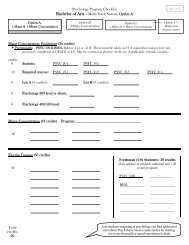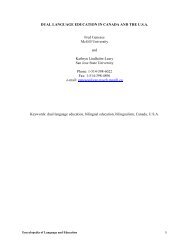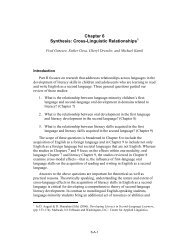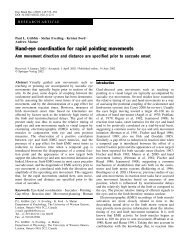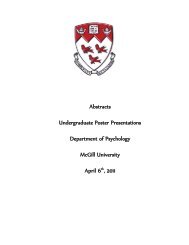A Short Guide to Raising Children Bilingually - McGill University
A Short Guide to Raising Children Bilingually - McGill University
A Short Guide to Raising Children Bilingually - McGill University
You also want an ePaper? Increase the reach of your titles
YUMPU automatically turns print PDFs into web optimized ePapers that Google loves.
a short guide <strong>to</strong><br />
<strong>Raising</strong> <strong>Children</strong><br />
<strong>Bilingually</strong><br />
Fred Genesee, <strong>McGill</strong> <strong>University</strong><br />
Want <strong>to</strong> raise your children bilingually<br />
but aren’t sure where <strong>to</strong> start?<br />
This guide will get you moving in the<br />
right direction in no time!<br />
Reprinted with permission from Multilingual Living Magazine: www.biculturalfamily.org
a short guide <strong>to</strong><br />
<strong>Raising</strong> <strong>Children</strong><br />
<strong>Bilingually</strong><br />
Fred Genesee, <strong>McGill</strong> <strong>University</strong><br />
Want <strong>to</strong> raise your children bilingually<br />
but aren’t sure where <strong>to</strong> start?<br />
This guide will get you moving in the<br />
right direction in no time!<br />
All children learn at least one language.<br />
Many children around the world learn more than one language and they<br />
do this in different ways. Some children learn two, or more, languages<br />
from birth. Other children begin <strong>to</strong> learn a second language when they<br />
go <strong>to</strong> daycare or preschool and an increasing number of children learn<br />
a second language in immersion programs when they start school. In<br />
this article, I focus on children who learn two languages from birth, or<br />
shortly after birth. I focus on children who learn two languages and do<br />
not comment on children who learn more than two. In other words, I<br />
focus on children who have two first languages.<br />
Learning two languages from birth occurs when parents speak<br />
different languages and decide <strong>to</strong> use their different languages <strong>to</strong> raise<br />
their child. In other families, the parents may speak the same language,<br />
but it is different from the language used in the community at large;<br />
for example, Spanish- or Chinese-speaking parents in the U.S. These<br />
parents might decide <strong>to</strong> use only Spanish or only Chinese at home<br />
while the child is exposed <strong>to</strong> English with most people they encounter<br />
outside the home. In yet other cases, children may be under the care<br />
of caregivers who speak a language that is different from that of their<br />
parents; for example, English-speaking parents in New York City who<br />
employ Spanish-speaking nannies <strong>to</strong> care for their child during the day<br />
while the parents are at work. Or, the source of the other language might<br />
be grandparents who speak a heritage language that is not spoken<br />
widely in the child’s community. <strong>Raising</strong> children bilingually raises lots<br />
of questions. I have tried <strong>to</strong> answer some of those questions below. It<br />
is important <strong>to</strong> emphasize that my suggestions below are very general<br />
and do not necessarily apply <strong>to</strong> all situations for all parents and children.<br />
Ultimately, each family must make the best decisions for themselves. The<br />
comments that follow do not concern cases where children are learning<br />
one language at home and another language in school. This is another<br />
<strong>to</strong>pic.<br />
2 Multilingual Living Magazine - Jan/Feb 2007 - www.biculturalfamily.org
Multilingual Living Magazine - Jan/Feb 2007 - www.biculturalfamily.org 3<br />
PHOTOS: © iS<strong>to</strong>ckpho<strong>to</strong>.com/lisegagne
4 Multilingual Living Magazine - Jan/Feb 2007 - www.biculturalfamily.org
1. Is it a good idea <strong>to</strong> raise my child bilingually?<br />
There are many good reasons for raising children bilingually. First and foremost are personal<br />
and family reasons. If members of the immediate family or extended family include people<br />
who speak other languages, then it is a benefit for everyone if your child speaks their<br />
languages. This is especially true if some family members speak only one language and might<br />
be cut off from communication with your child if he/she does not learn their language.<br />
The advantages of being bilingual or multilingual go beyond the family. Research has shown<br />
that children who are fluent in two languages also have cognitive advantages in comparison<br />
<strong>to</strong> those who speak only one language. For example, they are better at solving problems<br />
that involve focusing on relevant information while ignoring irrelevant information. Even<br />
bilinguals who are 60 or 70 years of age demonstrate these kinds of advantages.<br />
Clearly, there are also advantages that come from knowing other languages when you child<br />
is old enough <strong>to</strong> read and write and use computers. There is a wealth of information available<br />
in print, electronic and other media nowadays. The potential for accessing all that information<br />
is much greater for those who know more than one language and are limited for those who<br />
know only one. Of course, knowing a language like English is important because it is the<br />
most widely used second language in the world. It is widely used for communication about<br />
science, politics, financial matters, education, and other <strong>to</strong>pics, and is used extensively on the<br />
internet as well as in print and on radio, television, and so on. People who speak additional<br />
languages along with English have access <strong>to</strong> many more of these sources of information than<br />
those who know only English.<br />
Finally, there are many personal advantages from knowing additional languages. There<br />
are lots of job opportunities in international businesses and governments that require<br />
competence in two or more languages. Large international businesses need well educated<br />
bilinguals <strong>to</strong> work in the global market place; governments need multilinguals who can<br />
work in embassies and government offices around the world; and many other sec<strong>to</strong>rs of the<br />
economy (such as education, science) have job opportunities for those who are bilingual.<br />
Travel opportunities are also much greater for those who speak additional languages.<br />
2. Is it normal for children <strong>to</strong> learn two languages at the same time?<br />
Based on the number of children around the world who are raised speaking more than one<br />
language, bilingual acquisition is probably more “normal” than monolingualism. It has been<br />
estimated that there may be more children who grow up learning two or more languages<br />
than children who learn only one. More importantly, there is no scientific reason <strong>to</strong> think<br />
that young infants’ brains are equipped <strong>to</strong> learn only one language in early childhood. In<br />
fact, there has been a lot of research on infants and young children who are learning two<br />
languages from birth, and these studies show that children go through the same basic<br />
miles<strong>to</strong>nes in language acquisition as those who learn only one language. Bilingual children<br />
begin <strong>to</strong> babble at the same time as monolingual children; they say their first words at the<br />
same age as monolingual children; they start <strong>to</strong> produce multi-word sentences at the same<br />
time; and so on.<br />
There are differences, of course, between bilingual and monolingual children. The learning<br />
task for bilinguals is much more complex and this sometimes may result in short delays or<br />
small differences in learning. For example, studies have found that 15 month old infants<br />
learning two languages may be delayed by 2 or 3 months in their ability <strong>to</strong> distinguish new<br />
words that that sound similar <strong>to</strong> each other (e.g., “bit” vs. “bet”) in comparison <strong>to</strong> monolingual<br />
children. But, in the long run, this short delay has an insignificant effect on bilingual children’s<br />
overall learning. In fact, researchers suggest that this delay may be helpful for children who<br />
hear and must learn words from two languages with different sounds and sounds. It is a kind<br />
of flexibility that leaves them open <strong>to</strong> the greater diversity of words in two languages than<br />
monolinguals hear in only one.<br />
Bilinguals can differ from monolinguals even in<strong>to</strong> adulthood – they may pronounce<br />
words in slightly different ways; they may use unusual words from time <strong>to</strong> time; or they may<br />
construct sentences in different ways at times. Simply put, bilinguals have more language<br />
skills at their disposal and they use them in ways that may distinguish them from people who<br />
know only one language.<br />
Multilingual Living Magazine - Jan/Feb 2007 - www.biculturalfamily.org 5
3. Will my child become confused if we use two<br />
languages in the home?<br />
There is absolutely no evidence that children get confused<br />
when parents use both languages in the same sentence (or<br />
utterance) – what is referred <strong>to</strong> as code-mixing or codeswitching.<br />
As long as most people in the child’s family and<br />
community use only one language at a time, the child<br />
will learn that this is the appropriate way <strong>to</strong> use their two<br />
languages. There is a lot of research showing that even<br />
children in the earliest stages of bilingual development<br />
know how <strong>to</strong> use their languages separately, even with<br />
strangers they have never met before. If children are growing<br />
up in families and communities where two languages are<br />
often mixed in the same sentences or conversations, then,<br />
of course, children will learn these patterns of mixing. This<br />
makes sense because mixing is useful in their community. If<br />
the norm in the community in general, however, is <strong>to</strong> keep<br />
the languages separate, then children will learn and use this<br />
pattern.<br />
4. Should I worry if my child mixes languages?<br />
Mixing languages in the same sentences or conversations<br />
is perfectly normal – all bilinguals do it, even adults. This<br />
phenomenon has been studied extensively in children and<br />
adults. Research on children has shown that most bilingual<br />
children keep their languages separate most of the time.<br />
When they mix it is often <strong>to</strong> fill in gaps in their vocabulary<br />
in one or the other language. Bilingual children rarely know<br />
exactly the same words in both languages and, as a result,<br />
they might use a word from one language while speaking<br />
the other language because they do not know the word in<br />
the language they are using. Sometimes bilingual children<br />
mix words in their two languages because there are specific<br />
concepts or meanings that can be expressed easily in one<br />
language but not the other. If a child wants <strong>to</strong> express that<br />
meaning or concept, she will have <strong>to</strong> use the word from<br />
the language that it belongs <strong>to</strong> even if it means mixing<br />
languages. In most cases, this strategy works because<br />
often the adults in the child’s life know both languages<br />
<strong>to</strong>o. As bilingual children get older, they mix in order <strong>to</strong><br />
express their bilingual identity when they are with other<br />
bilinguals. Bilingual adolescents and adults often mix with<br />
other bilinguals because it is who they are. In the same way,<br />
people who speak specific dialects of a language will use<br />
that dialect with others who speak it in order <strong>to</strong> express<br />
their common identity. Mixing does not mean that children<br />
are confused or impaired; they are simply using all of their<br />
language resources <strong>to</strong> express themselves.<br />
Yet other research on code-mixing by children has shown<br />
that even their mixed sentences are grammatically correct<br />
most of the time. For example, if a child inserts a word from<br />
one language saying something in the other language,<br />
he will insert the word in a place in the sentence that is<br />
grammatically correct according <strong>to</strong> both languages. Or if<br />
a child switches from one language <strong>to</strong> the other partway<br />
through a sentence, she will do it at a point in the sentence<br />
where it is permitted by both languages – bilingual children<br />
6 Multilingual Living Magazine - Jan/Feb 2007 - www.biculturalfamily.org<br />
do not break the grammatical rules of either language when<br />
they mix languages. This is also true of adult bilinguals.<br />
5. Will my child’s language learning be delayed<br />
because he/she has <strong>to</strong> cope with two languages at<br />
the same time?<br />
Research shows that bilingual children go through most of<br />
the major miles<strong>to</strong>nes in language development – babbling,<br />
first words, and grammatical development, at the same age<br />
as monolingual children, IF THEY ARE GIVEN ADEQUATE<br />
EXPOSURE TO BOTH LANGUAGES. Research indicates that<br />
when children divide their learning time equally between<br />
their two languages – that is, 50% exposure <strong>to</strong> one language<br />
and 50% <strong>to</strong> the other, their two languages develop like<br />
that of monolingual children for the most part. However,<br />
bilingual children may show delayed or even incomplete<br />
development in one of their languages if their exposure <strong>to</strong><br />
that language is <strong>to</strong>o limited. It is clear that children learning<br />
two languages at the same time do not need as much<br />
exposure <strong>to</strong> each language as monolingual children get for<br />
their one. However, there is a minimum level of exposure<br />
below which the development of that can be delayed and<br />
incomplete. We do not have solid scientific evidence <strong>to</strong> tell<br />
us what that minimum amount of exposure is. Our best<br />
guess at this time is that bilingual children must be exposed<br />
<strong>to</strong> a language during at least 30% of their <strong>to</strong>tal language<br />
exposure if their acquisition of that language is <strong>to</strong> proceed<br />
normally. Less exposure than this could result in incomplete<br />
acquisition of that language.<br />
It is common <strong>to</strong> find that the vocabulary of preschool<br />
bilingual children is less than that of monolingual children if<br />
you examine each language separately, even if the bilingual<br />
child’s exposure <strong>to</strong> both languages is divided equally<br />
(50:50). However, if you examine their <strong>to</strong>tal vocabulary<br />
in both languages by counting all words for different<br />
concepts regardless of what language they are in, bilingual<br />
children have vocabularies that are the same size or even<br />
larger than those of monolingual children. Early differences<br />
in vocabulary between bilingual and monolingual children<br />
may be due <strong>to</strong> several fac<strong>to</strong>rs, none of which are signs of<br />
deficit or impairment. For example, all children have limited<br />
memory capacities and, thus, all children initially have<br />
limited vocabularies. Because bilingual children must share<br />
their limited memory with two languages, they can s<strong>to</strong>re<br />
fewer words in each language than monolingual children,<br />
but the same number, or more words when you consider<br />
both languages. Another explanation of bilingual children’s<br />
smaller vocabularies in each language is related <strong>to</strong> the<br />
learning environment. Many bilingual children do not have<br />
<strong>to</strong>tally equivalent vocabularies in both languages because<br />
they often learn each language from different people and/<br />
or in different settings. If these people talk about different<br />
things, the child will learn vocabulary in each that is specific<br />
<strong>to</strong> what is being talked about. This can persist even in<strong>to</strong><br />
adulthood and represents a relatively minor problem for<br />
most bilinguals.
6. Will my child’s grammar suffer?<br />
As we have already seen, bilingual children who have<br />
adequate exposure <strong>to</strong> both languages exhibit the same<br />
pattern of grammatical development as monolingual<br />
children and they go through the various stages of<br />
grammatical development as monolingual children.<br />
They also can keep their two grammars separate so<br />
that they avoid using the grammar of one language<br />
while speaking the other language. <strong>Children</strong> who get<br />
<strong>to</strong>o little exposure <strong>to</strong> one of their languages may not<br />
acquire complete grammatical competence in that<br />
language and, in these cases, they may use the grammar<br />
of their stronger language <strong>to</strong> express themselves in<br />
their weaker language. This is often the case for children<br />
who acquire a second language in school. Of course,<br />
the level of sophistication that children acquire in the<br />
grammar of each language will depend on the level of<br />
sophistication of the language that people around them<br />
use. This means that it is a good idea for parents, other<br />
caregivers, educa<strong>to</strong>rs, and others in the community <strong>to</strong><br />
provide enriched as well as continuous exposure in each<br />
language.<br />
7. Should we use the one-parent, one-language<br />
(OP/OL) rule in our home?<br />
Parents are often <strong>to</strong>ld that they should use the oneparent,<br />
one-language rule in the home because it ensures<br />
that their children will not get confused by hearing their<br />
parents use both languages at the same time. There is<br />
no evidence that following this rule helps children keep<br />
their two languages separate. As was said before, as long<br />
as most people in the child’s life use only one language<br />
at a time, the child will also learn <strong>to</strong> keep their two<br />
languages separate. The one-parent, one-language rule<br />
is a useful strategy for parents <strong>to</strong> use with their children<br />
<strong>to</strong> ensure that their children get adequate exposure <strong>to</strong><br />
both languages; otherwise, there might be a tendency<br />
<strong>to</strong> favor one language over the other. The OP/OL rule<br />
helps <strong>to</strong> make sure that this does not happen.<br />
In some families, the OP/OL rule may not be the best<br />
strategy. For example, if one of the languages the child<br />
is learning is not spoken by anyone outside the family,<br />
then it may be a good idea for both parents <strong>to</strong> use<br />
only that language. This will ensure that the child gets<br />
sufficient exposure <strong>to</strong> it <strong>to</strong> acquire it well. If children go <strong>to</strong><br />
daycares or pre-schools where the societally-dominant<br />
language is used or of if they have neighborhood friends<br />
who speak the societal language, they will get lots of<br />
exposure <strong>to</strong> the societal language. As a result, they will<br />
most certainly acquire full competence in that language<br />
because everyone around them uses it. Emphasizing<br />
the non-societal language in the home may be the<br />
best strategy <strong>to</strong> adopt in families that speak a minority<br />
language that is not widely used outside the home.<br />
8. What about children with language impairment?<br />
Is it a good idea for them <strong>to</strong> learn two languages<br />
at the same time?<br />
<strong>Children</strong> with language impairment are children who<br />
have difficulty acquiring the vocabulary, grammar and<br />
conversational skills of language in comparison <strong>to</strong><br />
typically developing children. These children’s learning<br />
difficulty is restricted <strong>to</strong> language learning because they<br />
usually have normal cognitive development, no obvious<br />
neurological impairments, and normal socio-emotional<br />
and perceptual development. <strong>Children</strong> with language<br />
impairment often experience difficulty and even failure<br />
in school because the linguistic demands in school are<br />
<strong>to</strong>o great. It is commonly thought that children with<br />
language impairment should only learn one language<br />
because learning two exceeds their language learning<br />
capacity and could result in even greater impairments<br />
and delays.<br />
We do not have as much research on children with<br />
language impairment who are raised bilingually as we<br />
would like. However, the research evidence that we do<br />
have suggests that children with language impairment<br />
can become learn and use two languages fluently<br />
despite their impairment. They exhibit language<br />
impairments in both languages, but their impairments<br />
Multilingual Living Magazine - Jan/Feb 2007 - www.biculturalfamily.org 7
are of the same nature and magnitude as those of<br />
monolingual children with impairment. At the same<br />
time, they develop proficiency in two languages. At<br />
present, there is no scientific evidence <strong>to</strong> suggest that<br />
children with language impairment should be limited <strong>to</strong><br />
only one language on the grounds that this will facilitate<br />
their language learning and avoid language difficulties.<br />
<strong>Raising</strong> children with language impairment bilingually is<br />
especially important in families and communities where<br />
knowing two languages is important and where not<br />
knowing one of the languages would restrict the child’s<br />
interactions with other family members or with members<br />
of their community.<br />
9. Are there circumstances when raising children<br />
bilingually is not a good idea?<br />
It may not be a good idea <strong>to</strong> raise children bilingually<br />
if parents cannot provide the learning environment<br />
that is needed <strong>to</strong> support the development of both<br />
languages. For example, take a family for whom English<br />
is the dominant language of both parents and they live<br />
in a community where another language is spoken. If<br />
they are living in this community for only a short period<br />
of time because one of the parents has a short-term job<br />
placement there, it may not be worthwhile for the child <strong>to</strong><br />
learn the new language since they will not have enough<br />
exposure <strong>to</strong> the language <strong>to</strong> really learn it. Recall that<br />
children need long term exposure <strong>to</strong> language if they are<br />
<strong>to</strong> develop full competence.<br />
In a related vein, raising children bilingually may not<br />
be advisable if exposure <strong>to</strong> one of the languages is going<br />
<strong>to</strong> be interrupted or inconsistent – because the family<br />
moves a lot or because of changes in the composition<br />
of the family that will result in a loss of someone who is<br />
the primary speaker of that language. Young children<br />
often react badly <strong>to</strong> inconsistent or irregular exposure <strong>to</strong><br />
language; they like consistency. Thus, if parents decide <strong>to</strong><br />
raise their child bilingually, they should do so only if they<br />
can provide continuous and extended exposure <strong>to</strong> both<br />
languages.<br />
Also, it may not be a good idea <strong>to</strong> raise children<br />
bilingually if at least one parent or child caregiver in<br />
the family does not speak each language fluently. In<br />
such cases, the parents may lack sufficient competence<br />
<strong>to</strong> provide the enriched language exposure the child<br />
needs <strong>to</strong> develop full competence. If there is a child<br />
caregiver who can supplement the parents’ use of their<br />
weaker language and if that caregiver is with the child<br />
for sufficient periods of time during the week, then the<br />
parent’s incomplete competence in the language may<br />
not be so serious.<br />
In sum, it is not a good idea <strong>to</strong> start raising children<br />
bilingually if you cannot keep it going or if you lack the<br />
linguistic competence yourself <strong>to</strong> nurture your child’s<br />
language development. This caution does not apply<br />
<strong>to</strong> children who are attending bilingual or immersion<br />
programs where a second language is used for instruction<br />
for an extended period of time. These programs are<br />
very effective ways of helping your children become<br />
bilingual.<br />
8 Multilingual Living Magazine - Jan/Feb 2007 - www.biculturalfamily.org<br />
10. What do I need <strong>to</strong> do <strong>to</strong> make sure my child will<br />
learn both languages fully?<br />
As we have seen, learning two languages in infancy<br />
and early childhood is as natural as learning only one<br />
language. Young children have the capacity <strong>to</strong> acquire<br />
full competence in two languages. While this is true, it is<br />
also true that the level of competence and the range of<br />
competencies that children acquire in each of their two<br />
languages depend critically on the learning environment.<br />
<strong>Children</strong> need continuous, sustained, and enriched<br />
exposure <strong>to</strong> both languages if they are <strong>to</strong> acquire full<br />
competence in both. Parents must take whatever steps<br />
they need <strong>to</strong> ensure that their child is actively exposed <strong>to</strong><br />
both languages preferably on a daily basis for a sustained<br />
and continuous time period. Active exposure means that<br />
children not only hear other people using each language,<br />
but they are actively involved in using each language.<br />
<strong>Children</strong> with only passive exposure <strong>to</strong> language, by<br />
overhearing adults for example, or watching TV, will<br />
not develop the ability <strong>to</strong> use the language proficiently.<br />
If children are <strong>to</strong> develop competence expressing<br />
themselves in two languages, they must be actively<br />
engaged in using both languages with others who know<br />
those languages.<br />
Motivating children <strong>to</strong> use both languages can<br />
sometimes be the biggest challenge in raising children<br />
bilingually. This is especially true when it comes <strong>to</strong> using<br />
a language that is not used widely outside the home.<br />
Often young children prefer <strong>to</strong> use the language that<br />
other children around them are using and they may
hesitate <strong>to</strong> use the “family” language if it is not used by their friends.<br />
In these cases, parents must devise strategies <strong>to</strong> motivate their<br />
child <strong>to</strong> use the language – for example, by creating playgroups<br />
with other children who speak the language or by visiting relatives<br />
who speak the language. Otherwise, the child may not see the<br />
value in using it and may even feel embarrassed using it. Parents<br />
should not be discouraged if children do not use both languages<br />
early in development. Some children, even monolingual children,<br />
take longer <strong>to</strong> get started and are not as vocal as other children. It<br />
does not mean that switching <strong>to</strong> only one language is advisable.<br />
Patience and effort will pay off when children grow up and have the<br />
benefits of being bilingual.<br />
Fred Genesee is Professor in the Psychology<br />
Department at <strong>McGill</strong> <strong>University</strong>, Montreal. He<br />
has served on the TESOL Board of Direc<strong>to</strong>rs,<br />
Executive Committee of American Association<br />
for Applied Linguistics, ACTFL Foreign Language<br />
Standards Steering Committee, TESOL ESL<br />
Committee on Performance and Assessment<br />
Further reading suggestions:<br />
Baker, C. (2000). A Parent’s and Teachers’ <strong>Guide</strong> <strong>to</strong><br />
Bilingualism. Clevedon, Eng.: Multilingual Matters<br />
www.multilingual-matters.com.<br />
Bilingual Family Newsletter.<br />
www.bilingualfamilynewsletter.com.<br />
Genesee, F., Paradis, J., & Crago, M. (2004). Dual Language<br />
Development and Disorders. Baltimore, Maryland: Brookes.<br />
Marcos, K. (2000). Promoting a Language Proficient<br />
Society: What You Can Do. www.cal.org.<br />
Acknowledgements: I would like <strong>to</strong> thank<br />
Caroline Erdos (Psychology, <strong>McGill</strong>), Elena Nicoladis<br />
(<strong>University</strong> of Alberta), and Liz Howard (<strong>University</strong> of<br />
Connecticut) for helpful comments on a draft of this<br />
article.<br />
Standards, and the National K-12 Foreign Language Resource Center. He has conducted extensive research on alternative<br />
forms of bilingual and immersion education and is currently conducting research on students who are at-risk for language<br />
and reading impairment in French immersion programs in Canada. He is the author numerous scientific research reports<br />
and books, including Dual Language Instruction: A Handbook for Enriched Education (Heinle & Heinle, 2000, with Nancy<br />
Cloud and Else Hamayan), Dual Language Development and Disorders (with J. Paradis & M. Crago, Brookes) and Educating<br />
English Language Learners (with K. Lindholm-Leary, W. Saunders, & D. Christian, Cambridge <strong>University</strong> Press). His current<br />
research interests include the language and literacy development of at-risk students in bilingual programs, language development in cross-language<br />
adopted children, and simultaneous bilinguals.<br />
Multilingual Living Magazine - Jan/Feb 2007 - www.biculturalfamily.org 9



